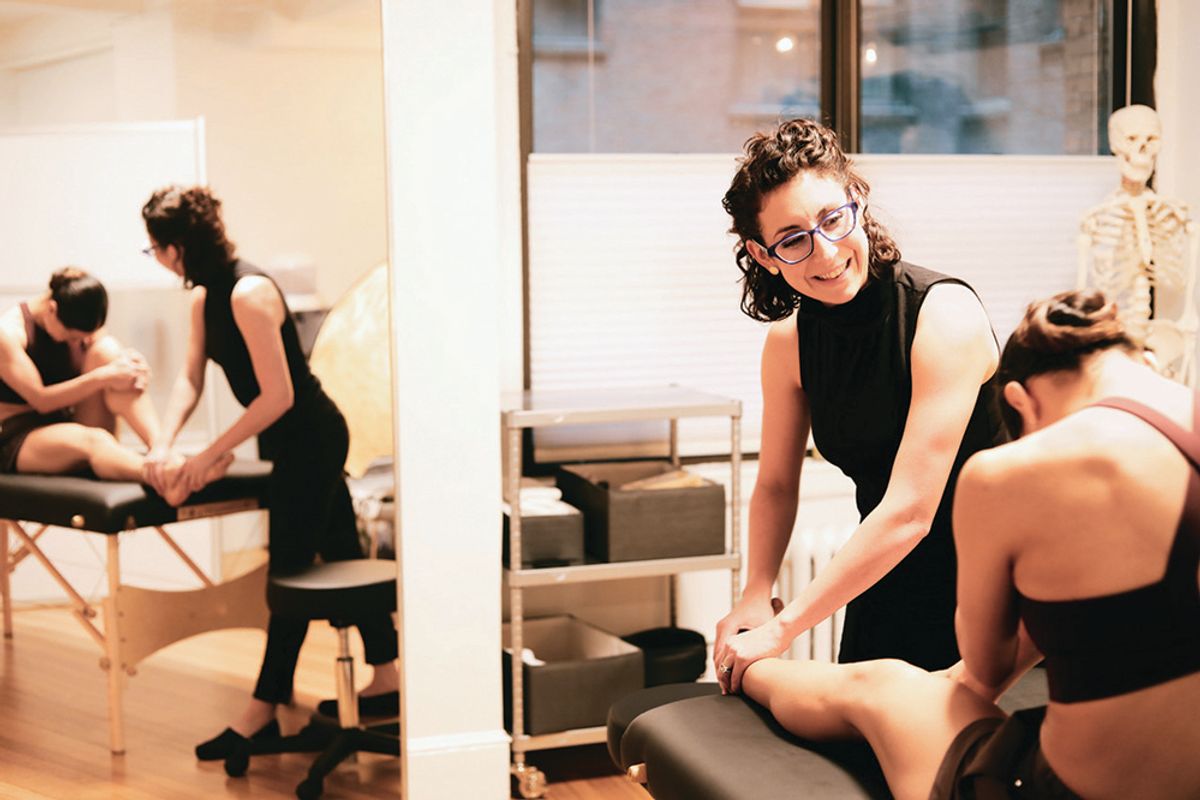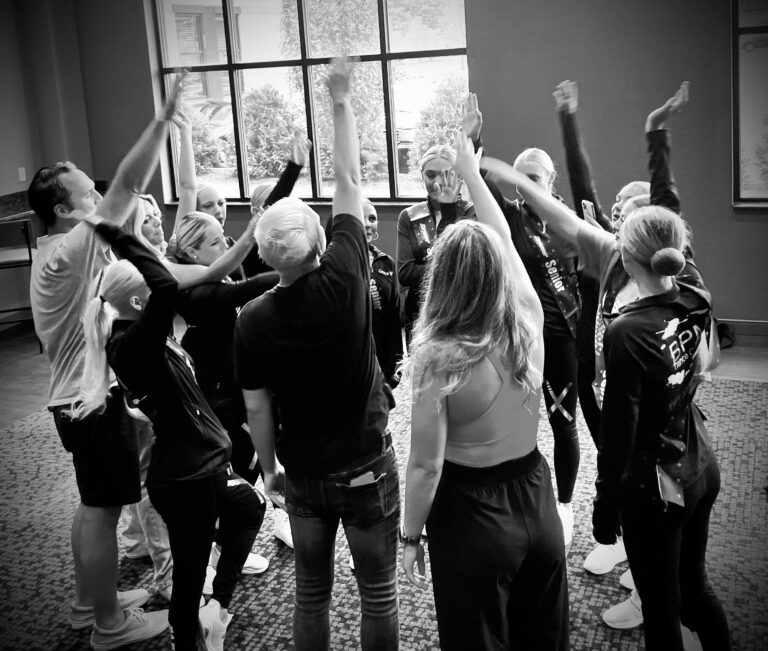
Picture the knee joint as a crowded intersection in a busy city, with people and cars moving through it: up and down, from side to side. When this junction is flowing smoothly, traffic is a breeze and it is easy to get to where you need to be. But when there is an accident or stalled vehicle anywhere linked to the crossing, your route is derailed.
“The knee doesn’t work in isolation,” says Marissa Schaeffer, a physical therapist at Alvin Ailey American Dance Theater in New York City. “It is constantly affected by forces above and below.”
As one of the largest joints in the body, the knee is a complicated interchange of tendons, ligaments and cartilage joining the thigh bone to the shin bone. A dancer’s knee is constantly managing forces up and down the kinetic chain. The tendons connect the leg muscles to bone and help move the joint and propel dancers into the air for jumps, while the ligaments work to join the bones and provide stability. The muscles commonly known as the quadriceps and hamstrings, as well as the adductors and abductors of the hip, act on the knee from above, while the calf muscles and anterior lower-leg muscles act from below. To keep this joint healthy, adequate strength and control of these muscle groups, relative to one another, are key.
Of the many acute and chronic knee injuries that can occur, Schaeffer most frequently sees overuse injuries in the pre-professional dancers she treats—patellofemoral knee pain, for instance, and patellar tendinopathy, commonly known as jumper’s knee. The bad news—that the cause of these injuries is usually the result of poor technique and inadequate conditioning—in this case is also the good news: With a focus on a proper neutral pelvis, true turnout, balancing strength between muscle groups and some specific cross-training, dance teachers can empower dancers to keep this joint healthy.
The Biggest Culprit: Turnout
“If you turn out from your hips, most dancers won’t have 180-degree turnout,” says Schaeffer. But in an effort to meet this near-universal demand, dancers borrow from other places. Some may use the floor to force turnout, trying to get more rotation from the tibia to make a nice line. But this misalignment in the lower leg changes the angle of stress and the way the patella is tracking. It also can cause increased torque across the knee, which stresses the tendons and ligaments that cross the joint. “And if you are in anterior pelvic tilt, which helps you force turnout, a chain reaction follows, pushing you back into hypermobility of knees,” Schaeffer adds.
As a first step, Schaeffer recommends finding and using a neutral pelvis in order to ease dysfunction along the chain. This more efficient and honest turnout may in fact be “less.” But the added benefits of controlling knee extension and hypermobility are value-adds in the long term. “My genuine hope is for dance teachers to recognize that 180 is not a realistic goal,” she says.
Promoting Self-Care
Over time, floor work and specific choreography can cause degenerative changes to the knee joint. Schaeffer insists that dancers should always have knee pads in their dance bags. And staying ahead of your students’ schedules and anticipating the rep that may be on the horizon can help you develop a specific cross-training routine to prepare. Schaeffer advises dancers to do their own research before an audition or class with a visiting professor. “You can look up a choreographer’s work on YouTube,” she says, “and get a sense of the demands. To protect your knees, you need adequate strength and control of the muscle groups.”
Muscle flexibility and core strength are important components of any cross-training routine for healthy knees. “Be sure to foam-roll and stretch, but also keep in mind that a muscle can appear tight or less extensible because it’s been overworked or it doesn’t have enough strength to withstand the demands you’ve placed on it,” she says. Also, there are a variety of reasons muscles can lack extensibility, including having poor core control. Sometimes it is as simple as adding in more squats or transverse abdominis work to an existing routine.
Ultimately, because stress to the knees can be referred from misalignments or weaknesses elsewhere in the body, the best tip Schaeffer can give is for dancers to be their own detectives: “Ask ‘What was different today? Could this pain be because of a different rep, or is it due to repeating the same thing over and over?'” While she prefers compression to icing to ease a little swelling, she advises seeing a physical therapist or medical professional if knee pain lasts more than a few days or is recurrent.

Photo courtesy of Schaeffer
A more honest and efficient turnout may be less than 180 degrees.
Preventive Exercises
“You don’t need more exercises,” says Schaeffer. “Just make the simple exercises more heady.” She favors tactile cues, allowing dancers to use their own hands on themselves to explore neutral spine in basic strength, conditioning and technique exercises. Here are two favorite ways to coach proper turnout with a neutral pelvis and an easing of stress in the knee joint.
Clamshells
1. Lie on one side with your knees bent, heels in line with your sitz bones.
2. With the feet touching, open your top knee to the ceiling, maintaining equal length on the side of your torso and keeping the pelvis stable.
3. Repeat to fatigue before moving to the other side.
Tip: If you have trouble keeping the hips quiet or maintaining the length of the top side of the torso, pad the underside of the torso near the low rib cage with a rolled-up tea towel or washcloth, or perform this exercise with your back against the wall.
Turnout on Rotating Discs
1. Place a piece of tape at the center of your knee (at the patella) and another one centered over the bump on the top end of your shin bone (tibial tuberosity). Check the alignment of the tape with your legs in parallel position in a mirror.
2. With a disc under each foot, practice moving into turnout, or external rotation, on the discs while maintaining the alignment of the tape. (You can set up the discs perpendicular to the mirror to do a self-check on the alignment of the tape, or ask a friend to help.)
3. Use this guide as you move through pliés and relevés in first position and variations on one leg. The tape can also be a helpful self-check while doing sautés in first position
The Whole Core
“Your pelvis is also included in the core, so if hips are shifting or rotating in the frontal and transverse planes due to weakness of the core—what I call ‘sassy hip’—it can also shift stress down to the knees,” says Schaeffer. If you are looking to strengthen the core to better support your knee health, don’t forget to include a thin skeletal muscle on top of it all—the diaphragm—since proper use of the breath is part of a strong center.”



